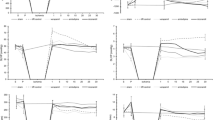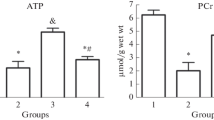Summary
The effect of 7-oxo PGI2 on function and metabolism of postischemic reperfused (30-min ischemia and 30-min reperfusion) rat hearts was studied with special regard to calcium overload as one of the main factors of the postischemic reperfusion damage to the heart. The drug (50 μg/kg i.p.) was applied 48 h prior to starting the experiments on isolated rat hearts (Langendorff preparation at 37 °C and constant perfusion pressure of 65 mm Hg). A late protective effect of 7-oxo PGI2 was manifested by an improved recovery of heart function during reperfusion and calcium overload, better preservation of myocardial ATP contents during ischemia and also after calcium overload, as well as by a normalization of the lactate content, otherwise extremely increased during ischemia. Electron microscopic data also supported the above results. The beneficial effect of pretreatment with PGI2 may be explained not only by its vasodilating action, but more by its membrane stabilizing effect with a consequently decreased sodium accumulation, potassium loss, as well as intracellular calcium overload.
Similar content being viewed by others
References
Chapman RA (1987) Calcium channels, the sodium-calcium exchange and intracellular sodium in the predisposition of the heart to the calcium paradox. Biomed Biochim Acta 46:8/9, S512–516
Džurba A, Ziegelhöffer A, Breier A, Vrbjar N, Szekeres L (1991) Increased activity of sarcolemmal (Na+/K+)-ATPase is involved in late cardioprotective action of 7-oxo-prostacyclin on the heart. Cardioscience (in press)
Lamers JMJ, Ruigrok TJC (1983) Diminished Na+/K+ and Ca2+ pump activities in the Ca2+ depleted heart: possible role in the development of Ca2+ overload during the Ca2+ paradox. European Heart Journal 4 (Suppl II):73–79
Linz W, Lau HH, Beek G, Schölkens BH (1988) Influence of the tromboxane synthetase inhibitor HOE 944, prostacyclin and indomethacin on reperfusion arrhythmias, cardiodynamics and metabolism in isolated ischemic rat hearts. Biomed Biochim Acta 47:10/11, 23–26
Parratt JR, Coker SJ, Wainwright CL (1987) Eicosanoids and susceptibility to ventricular arrhythmias during myocardial ischemia and reperfusion. J Mol Cell Cardiol 19 (Suppl 5):55–66
Pissarek M, Grunder W, Keller T, Goos H, Lindenau K-F, Krause E-G (1989) 31 P-NMR spectroscopy in the investigation of potential cardioprotective agents. 2. Leipziger Herzchirurgisches Symposium, April 19–22, Abstract-Band, Teil I - Vorträage V 48
Ravingerová T, Ziegelhöffer A, Tribulová N, Slezák J, Trégerová V (1990) Calcium paradox in the isolated rat heart — the effect of diltiazem. Physiologia Bohemoslovaca 39 (2):253–256
Schrör K, Thiemerman Ch, Ney P (1988) Protection of the ischemic myocardium from reperfusion injury by prostaglandin EI inhibition of ischemia induced neutrophyl activation. NaunynSchmiedeberg's Arch Pharmacol 338:268–274
Slezák J, Tribulová N, Schulze W, Ziegelhöffer A, Ravingerová T, Okoličány J, Trégerová V (1989) Differences in transmural distribution of cardiomyocyte injury. Ca paradox versus postischemic phenomenon. Biomed Biochim Acta 48:102–107
Szekeres L, Koltai M, Pataricza ZJ, Takáts I, Udvary E (1984) On the late antiischemic action of the stable PGI2 analogue. 7-oxo PGI2-Na and its possible mode of action. Biomed Biochim Acta 43:135–142
Szekeres L, Németh M, Szilvássy Z, Tósaki A, Udvary E, Végh A (1988) On the nature and molecular basis of prostacyclin induced late cardiac changes. Biomed Biochim Acta 47:6–11
Szekeres L, Balint Z, Karcsu S (1989) On the 7-oxo PGI2 induced late appearing long-lasting cytoprotective effect. In: Prostaglandins in Clinical Research Cardiovascular System. Alan R Liss Inc, New York, pp 143–147
Takáts I, Szekeres L (1985) Effect of 7-oxo prostacyclin (7-oxo PGI2) on the energetic state of ischemic myocardium. Acta Physiologica Hungarica 66:390
Tribulová N, Slezák J, Ravingerová T, Ziegelhöffer A (1990) Transmural nonhomogenity of calcium-induced heart injury. Physiologia Bohemoslovaca 39 (2):147–150
Udvary E, Szekeres L (1985) Prostacyclin antiischemic or cardioprotective? Proc 4th Cong Hung Pharmacol Soc, Budapest, V 3:333–338
Ziegelhöffer A, Slezák J, Ravingerová T, Tribulová N, Styk J, Trégerová V (1990) Analysis and study of factors involved in ischemic and reperfusion injury. Bratislava Med J 91:273–279 (in Slovak)
Author information
Authors and Affiliations
Rights and permissions
About this article
Cite this article
Ravingerová, T., Styk, J., Trégerová, V. et al. Protective effect of 7-oxo-prostacyclin on myocardial function and metabolism during postischemic reperfusion and calcium paradox. Basic Res Cardiol 86, 245–253 (1991). https://doi.org/10.1007/BF02190604
Received:
Issue Date:
DOI: https://doi.org/10.1007/BF02190604




